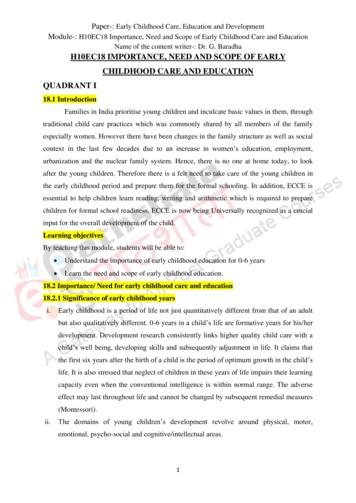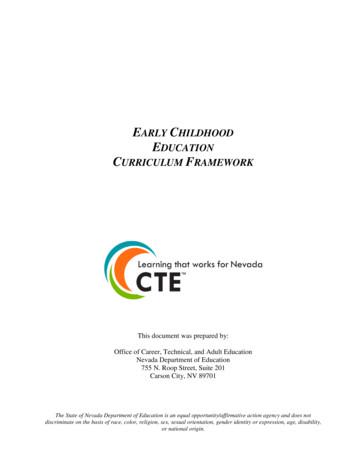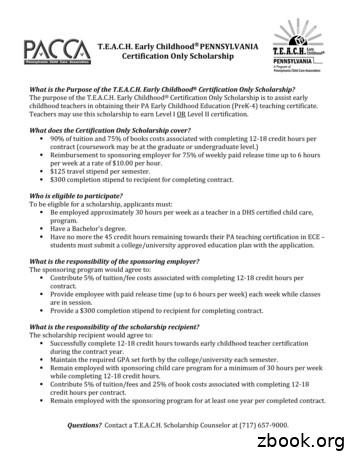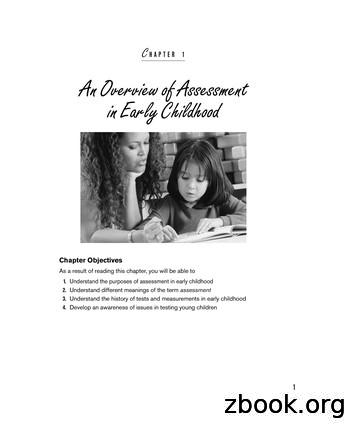New Jersey Early Childhood Education Preschool Classroom .
New Jersey Early Childhood EducationPreschoolClassroomTeachingGuidelinesNew Jersey Department of EducationDIVISION OF EARLY CHILDHOOD EDUCATION
New Jersey Department of Education 2019Division of Early Childhood EducationPreschool Classroom Teaching Guidelines1 Page
New Jersey Department of Education 2019Division of Early Childhood EducationPreschool Classroom Teaching GuidelinesForwardIn 2015, the New Jersey Department of Education utilized state and federal funding from the Race-tothe Top Early Learning Challenge Grant to develop the New Jersey Preschool Classroom TeachingGuidelines.The purpose of the guidelines is to outline and provide insight into multiple dimensions of professionalpractice for early childhood educators and to assist them in applying professional competencies andinstructional methods that are both developmentally appropriate and academically challenging for 3and 4-year-old children.Intended as a practical framework, the document includes broad-based principles, vignettes, teachingand learning goals, and specific classroom teaching practice examples. Reflections within the guidelineshelp communicate the complexity of the early childhood teacher’s role while also addressing keyelements of a high-quality early childhood program.The guidelines are the work product of a collaboration that spans local school districts, highereducation, national experts, and state and federal agencies. The initial version was developed inpartnership with William Paterson University (WPU), national researchers, New Jersey practitioners,and Early Childhood Education specialists at the New Jersey Department of Education. Dr. HollySeplocha, Professor of Early Childhood Education at WPU, led the development of the initial document.Regular updates to the New Jersey Preschool Classroom Teaching Guidelines continue to ensurerelevancy, ongoing professional development and inspiration for educators, families, and policymakers. The contributions of early childhood specialists at the New Jersey Department of Educationhelp assure that the New Jersey Preschool Classroom Teaching Guidelines reflect New Jersey schools,current research, best practice, and the unique strengths and assets of young children, families, andcommunities.The guidelines were originally released in 2015 and updated in 2019.2 Page
New Jersey Department of Education 2019Division of Early Childhood EducationPreschool Classroom Teaching GuidelinesNEW JERSEYSTATE BOARD OF EDUCATIONKathy Goldenberg . . PresidentBurlingtonAndrew Mulvihill Vice PresidentSussexMary Beth Berry . .HunterdonArcelio Aponte . .MiddlesexElaine Bobrove . .CamdenRonald K. Butcher GloucesterFatimah Burnam-Watkins . .Jack Fornaro UnionWarrenMary Elizabeth Gazi SomersetNedd James Johnson SalemErnest P. Lepore . HudsonJoseph Ricca, Jr. . MorrisSylvia Sylvia-Cioffi . MonmouthLamont O. Repollet, Ed.D., CommissionerSecretary, State Board of Education3 Page
New Jersey Department of Education 2019Division of Early Childhood EducationPreschool Classroom Teaching GuidelinesTable of ContentsIntroduction . 6Section 1: Young Children as LearnersDevelopmentally Appropriate Practice. 9Developmental Domains. 10Approaches to Learning . 15Executive Function . 16Self-Regulation . 16Importance of Play . 18Contextual Factors . 21Diverse Learners . 24Children Who Are Dual Language Learners . 28Children With Special Needs and Disabilities . 29Section 2: Planning to Support Children's LearningClassroom Environment and Room Arrangement . 31Interest Centers and Play Areas . 32Health and Safety . 36Gross Motor Space and Equipment . 37Schedules . 38Routines and Transitions . 39Building Classroom Community . 41Classroom Management . 42Class Rules . 43Challenging Behaviors . 44Adaptations to the Environment: Special Education . 46Section 3: Intentional TeachingScreening, Observation, Documentation, and Performance-Based Assessment . 49Using Data to Inform Instruction . 52Meaningful Interactions. 52Morning Meeting . 54Small Group Time. 55Whole Group Activity. 56Free Play and Choice Time . 574 Page
New Jersey Department of Education 2019Division of Early Childhood EducationPreschool Classroom Teaching GuidelinesAll Day Every Day . 58Scaffolding, Individualizing, and Teachable Moments . 60Fostering Engagement . 61Asking Questions. 62Strategies to Support Dual Language Learners. 64Section 4: Exploring CurriculumEnglish Language Arts: Early Literacy. 67Summary . 77Mathematics . 77Summary . 82The Arts . 82Science, Technology, Engineering, Art, and Mathematics (STEAM) in Preschool . 85Science and Nature . 87Technology and Engineering . 88Celebrating Diversity . 92Universal Design of Learning . 93Dual Language Learners . 94Section 5: Moving Beyond the ClassroomProfessionalism . 96Effective Teamwork within the Classroom . 97Reflective Teaching . 98Student Growth Objectives (adapted from AchieveNJ). 99Working With Other Professionals . 101Transitioning to Kindergarten . 101Collaborative Partnerships with Families and Communities . 101References .109Resources .1185 Page
New Jersey Department of Education 2019Division of Early Childhood EducationPreschool Classroom Teaching GuidelinesIntroductionFor many young children, preschool is their first experience in formal education and an educator isprivileged to be part of that experience.Being a preschool teacher is energizing, draining, exciting, challenging, and never boring. It takes morethan just enjoying being with young children. Being a preschool teacher also requires patience,creativity, enthusiasm, flexibility, humor, dedication, respecting diversity, knowledge of andappreciation for the development and learning of preschoolers, and support and appreciation for theuniqueness of families. As a preschool teacher, you set the stage for the child’s and family’s ideasabout school in general and attitude toward learning. Preschool teachers can make a lasting differencein the lives of children and their families.The New Jersey Department of Education Preschool Classroom Teaching Guidelines are a resource forpreschool teachers to guide, inform, and empower instruction in developmentally appropriate ways.The guidelines are designed to support and provide guidance in implementing the New JerseyPreschool Teaching and Learning Standards (2014). The Division of Early Childhood Education andFamily Engagement partnered with William Paterson University to produce the guidelines as part of acontinuous, comprehensive approach to early childhood education in New Jersey. The guidelinescompliment the New Jersey Kindergarten Program Guidelines and First through Third GradeImplementation Guidelines.These guidelines purposefully connect theory and best practice by: drawing on vignettes of classroom teaching to demonstrate what effective preschool teachers doand say. sharing concrete strategies for planning and implementing curricula in ways that young childrendevelop and learn. giving tips and advice to ensure environments, routines, and classroom management supportchildren’s needs and explorations and build classroom community. integrating the vital role of interactions and teachable moments exploring the roles and professional responsibilities of preschool teachers as leaders and inengaging families and communities.6 Page
New Jersey Department of Education 2019Division of Early Childhood EducationPreschool Classroom Teaching GuidelinesTo facilitate utilization of the guidelines the document is divided into five key sections:Section 1: Young Children as Learners provides a foundation and exploration for young children aslearners. It addresses developmentally appropriate practice, development in key domains, and play asan essential vehicle for learning. Also discussed are the influence of contextual factors and selfregulation on learning and development and how teachers can be responsive to the diversity oflearners.Section 2: Setting Up to Support Learning invites teachers to delve into the vital aspects of thelearning environment including room arrangement, centers, health and safety, gross motor space andequipment, and schedules. Teachers will also find support for building classroom community througheffective classroom management, schedules and routines, class rules, adaptations to the environment,and managing challenging behaviors.Section 3: Intentional Teaching presents teachers with assistance in being purposeful in observing,documenting, and assessing learning. As interactions are at the heart of teaching, effective strategiesfor interacting throughout the daily routine and activities, individualizing, fostering engagement, askingquestions, and supporting Dual Language Learners and children with special needs are included here.Section 4: Exploring Curriculum offers teachers a focus and strategies for content areas: Language andLiteracy, Mathematics, STEAM (Science, Technology, Engineering, Art, and Math), and the Arts.Approaches to planning meaningful instruction through an integration of content and skills that arerelevant and reflective of the children, including modifications in instruction for dual language learnersand for children with special needs are presented.Section 5: Moving Beyond the Classroom engages teachers in looking beyond the classroom tothemselves as reflective and committed professionals, team members, lifelong learners, collaboratorsin children’s transition to kindergarten, developers and users of Student Growth Objectives, and familyand community partners.7 Page
New Jersey Department of Education 2019Division of Early Childhood EducationPreschool Classroom Teaching GuidelinesSection 1: Young Children as LearnersPreschoolers, children ages three to five, learn best in secure, individualized settings in which theadults know and apply knowledge of child development and understand and respond to what makeseach child unique. Responsive teaching—being sensitive to individual children, fostering positiverelationships, and respecting children’s autonomy—supports cognitive, language and literacy, andsocial development (Hamre, Hatfield, Pianta, & Jamil, 2013). Thus, we know that one of the mosteffective ways young children learn is through positive relationships with their teachers. DombroJablon, and Stetson (2011, p. 5) describe “powerful interactions,” a relationship-based teachingstrategy that consists of, “very intentional and purposeful exchanges between a teacher and a childthat can have a significant and highly positive impact on learning.”Preschoolers also learn through active, hands-on experiences that allow them to use their senses toexplore and investigate. In this age group, children learn about science, math, and social studiesconcepts through experiences. While making playdough, they observe what happens when they addthe various ingredients, while painting they learn what colors to mix together to make a new color,and while playing in the house corner they learn how to control their impulse to grab a favorite propbecause they want the play to continue. Teachers plan the environment, activities and daily routineswith learning goals in mind based on knowing their children, and their knowledge and understandingof how children develop and learn. Teachers support hands-on learning by observing and respondingwith new activities, materials, questions, suggestions, and resources that build on interests and fostercontinued learning and skill development.Preschoolers are working hard to make sense of the world. They sort and categorize and combineobjects and ideas and sometimes their thinking is novel, but not necessarily correct. Teachers canintroduce the scientific method to help children plan and analyze the results of experiments.As discussed in a later section, preschoolers’ essential vehicle for learning is through play. Playfullearning experiences can be child-initiated or adult-directed (Epstein, 2014) and include construction,physical experiences, games, sensory explorations as when in the sandbox, and through pretend play,and later, high level socio-dramatic play with complex themes, characters, and story lines.Preschoolers acquire information from books, pictures, and engaging experiences such as field trips inthe community or visits by experts such as a veterinarian. In addition, direct teacher instruction playsa role in conveying important information that cannot be learned through direct experiences.This section reviews the definition and basic principles of developmentally appropriate practice, howpreschoolers develop in different domains, and the importance of viewing family, culture, language,and community assets as contributors to and supporters of children’s development.Decades of research suggest that children learn best when they are active (rather than passive), areengaged (not distracted), and find an activity meaningful, and when an activity is socially interactive(Hirsh-Pasek & Golinkoff, 2015, p. 18 Page
New Jersey Department of Education 2019Division of Early Childhood EducationPreschool Classroom Teaching GuidelinesDevelopmentally Appropriate PracticeThe term developmentally appropriate practice describes a framework for teaching and learning thatreflects children’s ages, individual characteristics, and cultural backgrounds. Whether creating anengaging classroom environment, leading activities, interacting with children, or documenting progress,effective preschool teachers are intentional in their application of developmentally appropriatepractice. They thoughtfully plan and implement a program that encourages development and learningfor all the children in their group. Developmentally appropriate practice includes three coreconsiderations, as follows (Copple & Bredekamp, 2009, pp. 9-10).1. Child development and learning: Preschool teachers apply their knowledge of what is predictableduring the preschool years. They practice life-long learning by studying new research about youngchildren’s development and the best ways to encourage learning in the preschool years. This childdevelopment knowledge is applied in all teachers do.2. Individual characteristics: Presc
The New Jersey Department of Education Preschool Classroom Teaching Guidelines are a resource for preschool teachers to guide, inform, and empower instruction in developmentally appropriate ways. The guidelines are designed to support and provide guidance in implementing the New Jersey Preschool Teaching and Learning Standards (2014).
Understand the importance of early childhood education for 0-6 years Learn the need and scope of early childhood education. 18.2 Importance/ Need for early childhood care and education 18.2.1 Significance of early childhood years i. Early childhood is a period of life not just quantitatively different from that of an adult
Early Childhood Education I L1 Early Childhood Education II L2 Early Childhood Education III L3C Early Childhood Education Advanced Studies AS The core course sequencing with the complementary courses provided in the following table serves as a guide to schools for their programs of study.
ECE 240 - Administration of Early Childhood Care and Education Programs (3) ECE 241 - Administration: Human Relations for Early Childhood Education (3) Colorado Mesa University B.A. Early Childhood Education - Early Childhood Special Education Advisor: Vail Shoultz-McCole vshoultz@coloradomesa.edu 970-255-2674
Early Childhood Care, Development and Education (ECCDE) is a term that is used interchangeably worldwide but refers to the same concept of early childhood education and cognitive development. The World Bank for instance refers to it as Early Childhood Care and Education, whereas UNESCO refers to it as Early Childhood Development Care.
T.E.A.C.H. Early Childhoodâ PENNSYLVANIA Certification Only Scholarship What is the Purpose of the T.E.A.C.H. Early Childhood Certification Only Scholarship? The purpose of the T.E.A.C.H. Early Childhood Certification Only Scholarship is to assist early childhood teachers in obtaining their PA Early Childhood Education (PreK-4) teaching certificate.
Center-Based and Family Child Care Early Childhood Education Reviewer The Early Childhood Education (ECE) Reviewer must meet one of the following sets of education and experience options: Education and Experience Option I 1. B.A., B.S., or advanced degree in early childhood education/child development or home
CHAPTER 1 An Overview of Assessment in Early Childhood Understanding Assessment in Infancy and Early Childhood Not too long ago, resources on early childhood assessment were limited to occa-sional articles in journals, chapters in textbooks on teaching in early childhood pro-grams, and a few small textbooks that were used as secondary texts in .
diploma in early childhood development & education If you have a natural love for children and a strong interest in early childhood education, then why not play an active role in shaping a child's growth with our Diploma in Early Childhood Development & Education [ECDE]?























